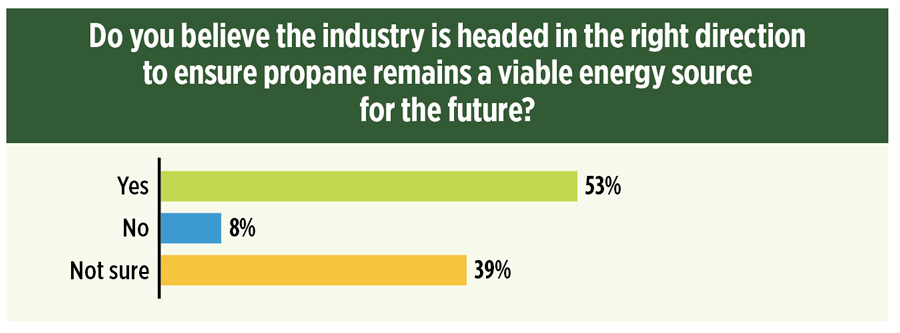2021 State of the Industry: Forging ahead
Call to action
Many survey takers recognize that while appealing to consumers is one problem, swaying legislators and regulators to act in propane’s favor is another, perhaps more urgent, problem.
Arguments about propane’s contributions to decarbonization and energy equity can be difficult to make in locales where fossil fuels are broadly criticized as contributors to climate change, and when federal, state and local policymakers translate that sentiment into laws and regulations.
“Propane (and natural gas) are very green for the environment,” says one marketer from Wisconsin. “The administration seems to think otherwise. That is concerning.”
John Bove of G.A. Bove Fuels in eastern New York thinks the industry should spend more resources on convincing policymakers to halt electrification than on consumers who, at least in his area, already recognize the value of propane. He says he’s busier than ever hooking up propane where natural gas is not available on the recommendation of builders and insurance companies. Yet, lawmakers in the region are considering a provision requiring all new homes to run on electricity or renewable energy.
Bove already speaks with policymakers in his community and does not plan to change his tack as a result of the industry’s new environmental messaging campaign. Regardless of propane’s clean-burning properties, electrification does not make sense in his area from cost or reliability standpoints – issues he says lawmakers can’t ignore.
“The consumer needs [propane],” he says. Many of the lawmakers themselves rely on propane power for second homes or propane generators in areas where the electric infrastructure is old; they don’t understand the full consequences of electrification, he adds.
A sizeable number of respondents – 27 percent – concur with Bove’s sense of urgency about political action but have been moved to take even more action as a result of the industry’s environmental messaging campaign. They express a need to be heard and to ensure policymakers are better informed about the environmental benefits of propane.
Yet, the majority of respondents – 56 percent – say they will not change their level of engagement as a result of the campaign. Some of these respondents, like Bove, already speak with policymakers and will continue their efforts. Others are inactive and point out obstacles to engagement.
Terry Fisher of South Florida Gas, for example, is enthusiastic about political engagement on the environmental front, but like many general managers tasked with sustaining and growing the business day to day, he finds it challenging to make lobbying a priority. The labor shortage has only further squeezed industry members’ time, he says.
A small but vocal subset of survey takers report disengaging from politics because they distrust their elected officials.
One Pennsylvania-based marketer reports uncertainty about speaking with policymakers because the process is “time-consuming and doesn’t seem to make much difference with [the] current administration.”
Galvanizing grassroots political engagement is a core strategy in the industry’s playbook to secure propane’s place in a clean energy future. NPGA President and CEO Steve Kaminski says that while NPGA and regional and state associations can lead the charge, conversations by propane marketers with their representatives are vital to success.
“In the current political climate, we need to shout from the rooftops louder than ever,” he says. “Propane’s inclusion in the recently passed federal infrastructure package demonstrates that our industry’s environmental impact and socioeconomic justice attributes are resonating in the halls of Congress.”
In addition to its lobbying efforts, NPGA works closely with propane marketers to facilitate conversations with representatives, including coordination of dozens of congressional site visits each year, adds Kaminski.
Planning ahead
Only 8 percent of survey takers say the industry is headed in the wrong direction to remain a viable energy source in the future, but a notable 39 percent say they’re not sure.
Those who think the industry is headed in the wrong direction would like to see innovative applications that will help propane compete against other energy sources – especially in the residential market – as well as more support for marketers to bring those innovations to market in a scalable way.
Those who are unsure suspect the unified environmental messaging campaign may not do enough to resolve the intense push for electrification in their areas.
“Good slogan but not sure of the urgency,” says a marketer based in Massachusetts and Rhode Island who marks environmental issues as the most important concern for the industry. “New England is under assault, and no one is listening.”
When asked if the industry is headed in the right direction, a California-based marketer says: “In some places, absolutely. In California, it’s going to be an uphill battle.”
Other marketers are not sure if the industry’s environmental messaging strikes the right notes to address other urgent problems they’re facing.
During a shaky year for propane fundamentals, many marketers cite supply and pricing issues as threats to the viability of their businesses going forward.
“All of the campaigns are a wasted effort if propane becomes too expensive,” says a Florida-based marketer.
A marketer from Pennsylvania brings up a longer-term problem with the growing export market: “Exports to other countries are dramatically impacting our domestic sales.”
The marketer is participating in the new environmental campaign, and appreciates that it helps keep the business current, but says “the crazy high energy prices right now cannot be ‘marketed’ away.”
Despite those points of contention, most survey takers agree that the environment must remain a focal point in the industry’s plan for the future

















